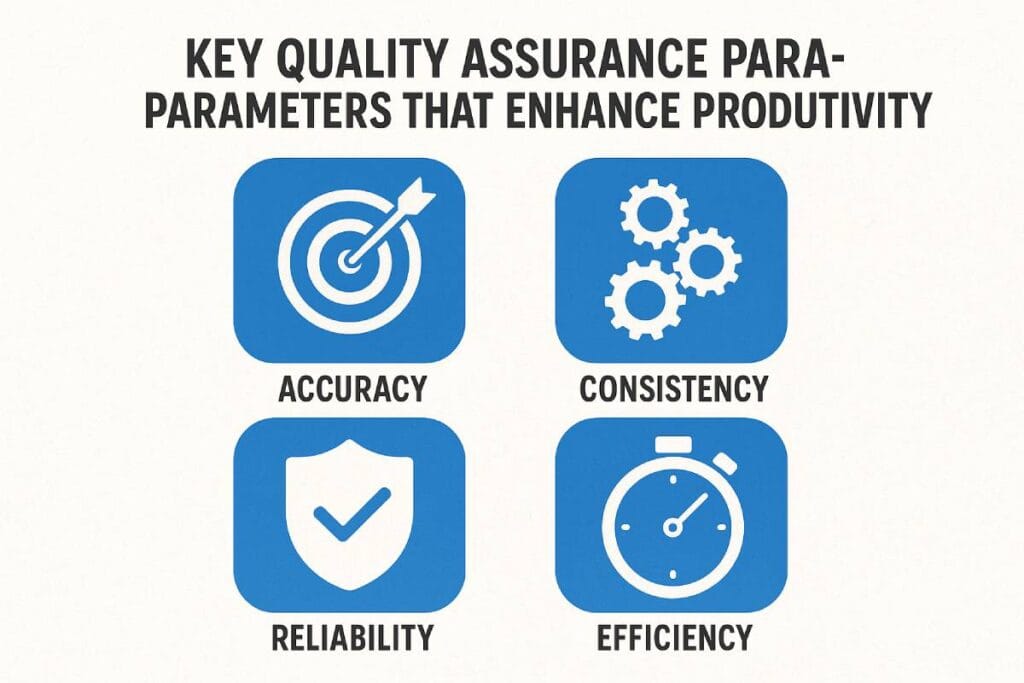Key Quality Assurance Parameters That Enhance Productivity

Introduction
In an increasingly competitive and fast-paced global market, quality assurance (QA) has become more than just a checkpoint — it’s now a strategic tool for driving efficiency, reducing costs, and building trust. By implementing the right QA parameters, organizations can drastically improve their overall productivity while maintaining high standards. But what exactly are these parameters that ensure robust QA and directly impact productivity?
1. Clear Quality Standards and Benchmarks
One of the foundational parameters of effective QA is the establishment of clear, measurable standards and benchmarks. These guidelines serve as the blueprint for what constitutes “acceptable quality.” Whether it’s ISO standards in manufacturing or OWASP in software security, well-defined benchmarks minimize ambiguity, speed up decision-making, and reduce the need for rework. Consistency in quality expectations ensures that all team members are aligned, contributing to smoother workflows and faster delivery times.
2. Rigorous Testing and Validation Protocols
Testing is not just about identifying flaws—it’s about validating performance under expected conditions. Structured QA frameworks like test-driven development (TDD), regression testing, and stress testing in software, or material durability tests in manufacturing, allow teams to catch issues early. This proactive approach reduces the likelihood of costly failures downstream and ensures that final products meet both functional and user-centric expectations, thereby streamlining future iterations.
3. Root Cause Analysis and Continuous Improvement
Productivity suffers when the same mistakes are repeated. Root Cause Analysis (RCA) is a key QA parameter that helps in identifying not just the symptoms, but the underlying cause of recurring issues. Incorporating tools like the 5 Whys, Pareto analysis, or fishbone diagrams enables teams to permanently eliminate defects and inefficiencies. When combined with a culture of continuous improvement (Kaizen), RCA leads to sustained productivity gains and evolving quality standards.
4. Documentation and Knowledge Management
Effective documentation ensures that quality protocols are repeatable and transferable. Whether it’s version-controlled QA manuals, test case repositories, or compliance logs, proper documentation saves time on training, onboarding, and audits. Moreover, it allows quality-related knowledge to be preserved and scaled across different teams or departments, reducing redundancy and accelerating operational velocity.
5. Automation and Digital QA Tools
Modern QA benefits enormously from automation. From CI/CD pipelines in software development to machine vision inspection in manufacturing, digital tools increase test coverage, minimize manual errors, and allow real-time monitoring. Automation not only enhances precision and speed but also frees human resources for higher-value activities like analysis and strategic planning — both of which contribute to increased productivity.
6. Team Communication and Feedback Loops
Finally, a high-performing QA system depends on clear communication and timely feedback. Agile and DevOps methodologies, for instance, emphasize rapid iteration and constant collaboration between QA, development, and operations teams. This real-time interaction leads to quicker issue resolution and adaptive planning. Transparent communication ensures that insights from QA processes are acted upon swiftly, keeping project timelines and quality objectives aligned.
Conclusion
Quality assurance is not a static department—it’s a dynamic, cross-functional process that touches every part of the production or service lifecycle. By focusing on parameters like clear standards, structured testing, RCA, documentation, automation, and communication, organizations can turn QA into a productivity engine. As the demands for speed, accuracy, and user satisfaction grow, investing in robust QA practices is no longer optional—it’s essential for sustainable success.
Source : Medium.com





Loved the breakdown! In today’s fast-paced digital world, platforms like tyy.AI Tools are game-changers for finding top AI solutions. For instance, if you’re looking to verify the originality of your work, you can check out AI Checker Essay. It’s a great example of how such directories can streamline decision-making and save time.